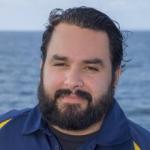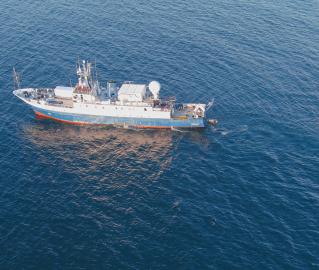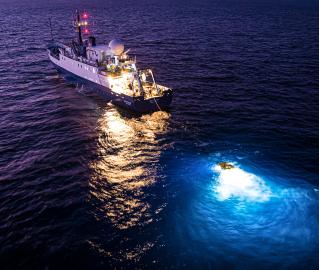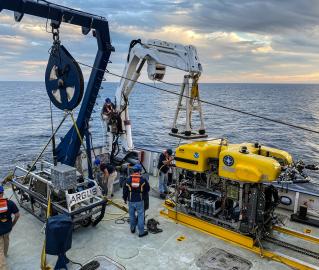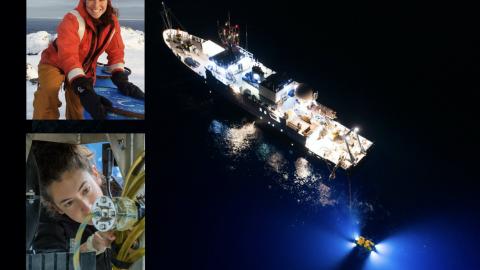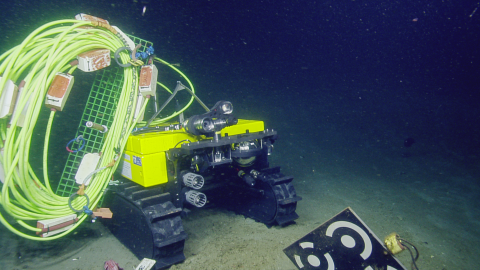The Exploration Vessel Nautilus mode of exploration uses two remotely operated vehicles (called ROVs for short). ROV Hercules is connected by a tether to ROV Argus and ROV Argus is connected to the ship using a long armored cable. Each ROV has one pilot to operate and oversee the safety of its systems. Within the larger expedition, each watch team has two ROV pilots, so as many as six ROV pilots are aboard Nautilus at any time. To “fly” ROV Hercules across the seafloor, pilots must work closely together and communicate clearly with the navigator in the control van to position the ROVs safely and avoid impacting each other or delicate features of the seafloor.
Flying From the Surface to the Seafloor
ROV pilots are engineers and technologists who maintain and control the large remotely operated vehicles (ROVs) the Corps of Exploration uses to explore the seafloor and water column. Pilots ensure the cameras, sampling tools, and sensors of each robot are ready for the science team to complete their goals. ROV Hercules pilots are typically senior pilots and are responsible for the overall operations while the vehicles are in the water. They are also responsible for ensuring the operational team communicates and works together to successfully complete the science objectives determined for each dive. ROV Argus pilots control ROV Argus and also take on additional tasks — such as monitoring the system’s many gauges and operating one of the manipulator arms — to support the Hercules pilot.
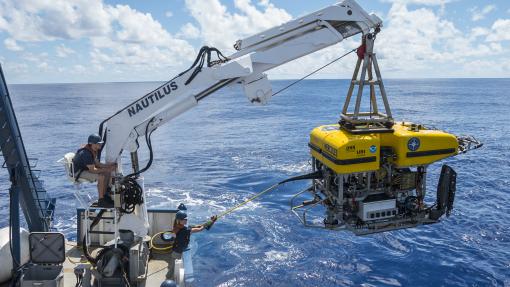
When the ROVs are deployed to the seafloor, pilots “fly” the vehicles for four hours at a time. While in the control van, the pilots sit side-by-side in front of a series of touchscreen monitors, joysticks, and keypads which are the controllers for different ROV systems. During a dive, Hercules pilots control the thrusters that move Hercules forward, backward, side-to-side, and vertically using a joystick and touchscreens. The pilot also controls the ROV’s right arm, a Kraft manipulator, to collect biological, geological, or water samples that help researchers answer questions about the seafloor or overlying water column. The Kraft arm is controlled by moving a miniature version of the arm in the control room.
“Learning to use the manipulator arm is a bit like learning to walk. You know you have all these joints and you know how they work, but you have to practice for a long time to get comfortable moving all the joints together”
Trevor Shepherd, ROV Hercules Pilot
Argus pilots control Hercules’ left arm, an ISE manipulator, using a 12-key control pad. The Argus pilot also controls the lateral thrusters which swivel Argus and the tilt of the high-definition camera to provide variable views of the seafloor as well as keeping a close watch on the tether between vehicles. Another important role is to control the winch onboard Nautilus to raise or lower Argus adjusting the ‘delta,’ or distance, between Argus and Hercules’ depths. Monitoring the delta depth ensures the tether doesn’t get pulled tight and yank ROV Hercules and prevents the ROVs from moving dangerously close together. Both pilots monitor systems looking for spikes or dips in oil pressure, temperature, and power to different systems like navigation, lights, cameras, or samplers.
A Pre-Dive A Day Keeps Maintenance Away
Being an ROV pilot also involves contributing to the maintenance, troubleshooting, and repairs of the ROVs. Maintaining ROVs between dives includes tasks like testing hydraulic pressure, installing and removing new sensors or sampling gear, cleaning equipment, designing new solutions to problems the team encounters, and repairing any systems that malfunction, as quickly and precisely as possible so expeditions can stay on schedule.
Pilots work together to conduct pre-dive checks that involve looking closely at and physically touching each component to ensure it’s functioning correctly. Pilots check that every pressure housing, thruster, sensor, camera, and light is mounted to the vehicle, that mountings are tightened, and that inputs and outputs are secure. Inputs and outputs could be pressure compensated oil, hydraulic oil, electrical power connection, and fiber data connection.
A pre-dive also includes checking that the deployment and recovery equipment is ready. Pilots check the lifting bale on ROV Hercules, the lift line on the crane, the signal strobe on the top of Hercules, and the strain relief on ROV Argus. There are mechanical checks that include all moving pieces of the vehicle, like the main HD Zeus camera pan/tilt bracket and freely-spinning thrusters — and pilots even tighten every fastener on the manipulator arm joint. The ROV’s sonar, sensor, and high-voltage systems are also checked before a dive is launched and the ROVs are lowered into the water by the ROV team, the Deck Chief, and other Nautilus team members.
Career Pathways
Hercules pilots have years of ROV training in the field and typically have university or technical school education in some form of engineering, or the equivalent in experience. One pathway to working with robotics is being a mechanical system engineer, building new tools and working with physical parts of these systems. Electrical specialists are also important to work with the networking, communications, and high-voltage systems that make up an ROV. Pilots learn from one another during every expedition and some Argus pilots may become fully trained Hercules pilots over several seasons. Many of the ROV pilots aboard Nautilus begin their journey in the Corps of Exploration as ROV Engineering interns in the Science & Engineering Internship Program as community college, undergraduate, graduate students, or early career professionals focused on engineering.
Within the Corps of Exploration, ROV pilots have degrees and certifications in many fields including ocean engineering, mechanical engineering, electrical engineering, electronics technician certification, biology, and computer sciences.
Other careers with similar skill sets include: systems engineer, electrical engineer, mechanical engineer, petroleum engineer, electrician, machinist, ocean engineer, computer-aided-design (CAD) drafter, architect, and more.




